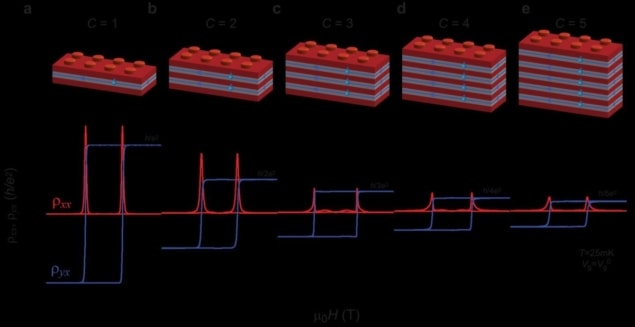
A new multi-layered topological insulator has enabled researchers in the US to achieve fast, highly efficient currents of electrons with no energy loss. Cui-Zu Chang and colleagues at Pennsylvania State University say they have exploited the quantum anomalous Hall (QAH) effect to create a “multi-lane highway’ for electrons, in which the current can be finely tuned. Through further improvements, their design could lead to new advances in quantum computing and small-scale electronic circuits.
First observed experimentally in 2013, the QAH effect is a key feature of some topological insulators – materials that are electrical insulators in the bulk, but excellent conductors on their surfaces or edges. Specifically, the effect is relevant for 2D topological insulators doped with magnetic impurities. Even in the absence of magnetic fields, electrons in these materials will flow in one direction along the edge of a sample, with virtually no energy dissipated as heat. This property is analogous to a divided highway where traffic flows freely in both directions on opposite sides of the road. Recently, physicists have been keen on using this effect to increase the speed and efficiency of information transfer in electronic circuits. Because this free flow could preserve quantum information encoded in electrons, the QAH effect could prove useful for use in future quantum computers.
Chang’s team created a stack of QAH insulators, containing alternating layers of magnetic and undoped non-magnetic topological insulators. Their aim was to increase their material’s “Chern number”: a value defining the number of channels along the edge of a sample that are fully topologically protected. While the Chern number of a conventional QAH insulator is one, the researchers achieved a value of five in their new design. Rather than a simple road, this structure was comparable to a multi-lane highway, where electrons could flow along five separate channels in each direction.
Fine tuning
Having demonstrated this effect, Chang and colleagues also showed how the Chern numbers of QAH insulators can be tuned – either by varying the doping concentration of the magnetic layers or changing the thicknesses of the insulating layers. Despite these modifications, the team was able to maintain zero energy dissipation along each edge channel, even with high amounts of electron traffic.

Magnetic topological insulators change phase under pressure
A shortcoming of the current design is that devices must be chilled to near absolute zero, precluding practical applications. The team is now developing more advanced materials that could operate at higher temperatures. They are also looking at ways to tune the Chern number in real time. If these efforts are achieved, multi-layered QAH insulators could find uses in areas including high-capacity, small-scale electronics. The materials could even be used in future quantum computers where electrons are used to transfer quantum information along numerous different channels.
The research is described in Nature.



